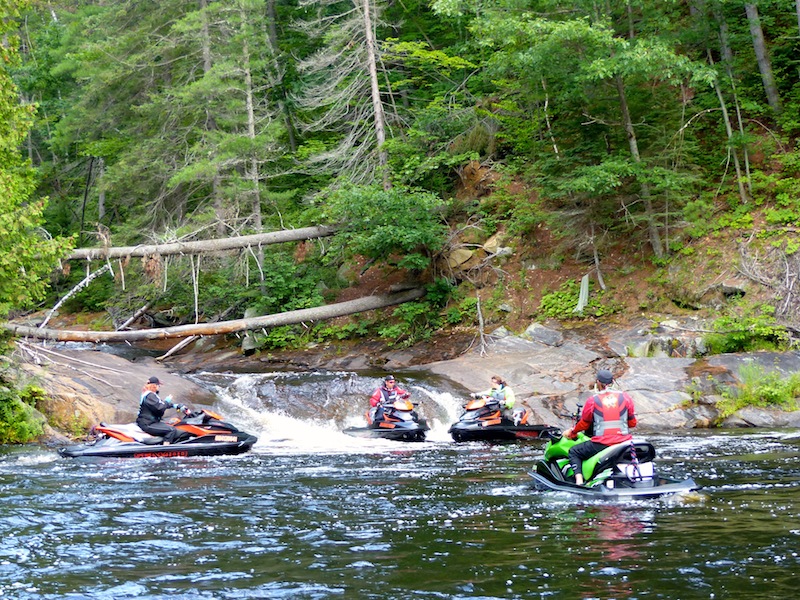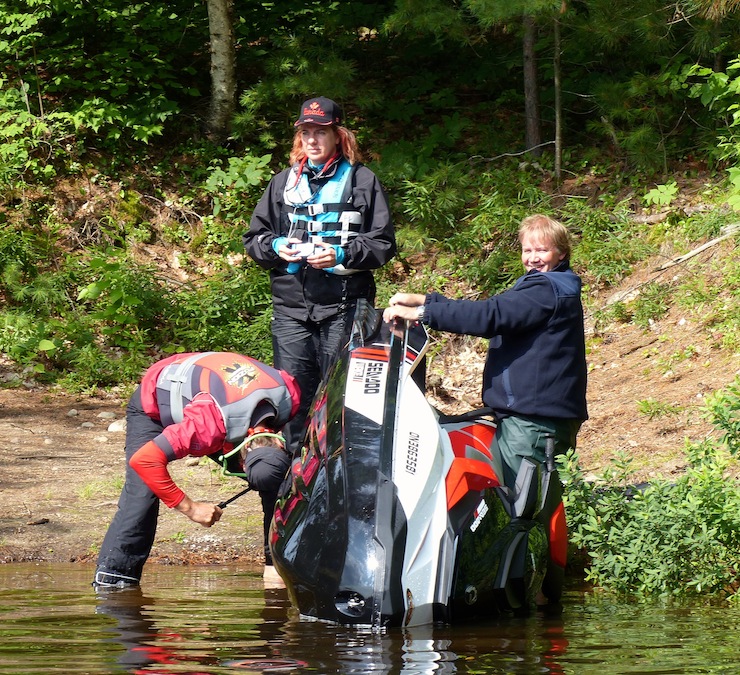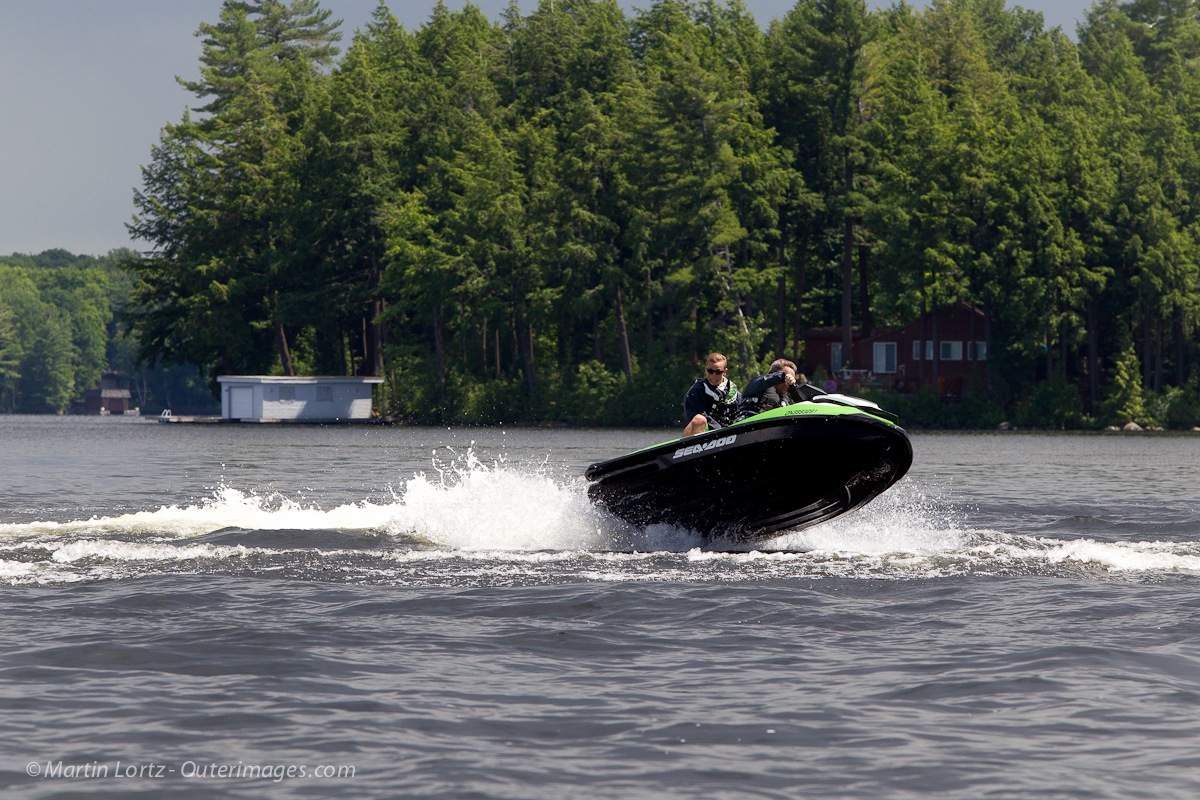Avoid Unique PWC Jet Propulsion Problems…
Related: 5 Common Breakdowns
What are jet propulsion cautions for your Sea Doo, jet ski or waverunner personal watercraft? The jet propulsion system that powers personal watercraft certainly has advantages over the propellers that drive most recreational boats. Typically, these extend down below the hull so their churning blades can pose a danger to people, pets or wildlife.
Propeller boats can’t go into as shallow water as jet skis. They can suffer damage from obstacles just under the surface. You have to be more careful with a propeller boat at a launch. But as I’ve learned from much Sea Doo riding experience, there are a few PWC jet propulsion cautions too, These will help both experienced jet ski riders and beginners on Sea Doo tours and PWC adventures…
Jet Propulsion Operating Caution
Underneath your jet ski, a powerful intake sucks in water and anything (or anyone) else nearby, so stay away. At the back of the PWC, that same water is expelled in a powerful thrust that drives the PWC forward. This jet stream can cause a painful body blow to anyone who happens to be immediately behind or boarding the jet ski at the same time an operator squeezes the throttle. Again, stay away unless boarding and then only if the operator knows what you’re doing.
Finally, part of the fun appeal of Sea Doo riding is your PWC’s turn-on-a-dime manoeuvrability. But the G-forces can easily fling an unprepared passenger into the drink. Or result in collision if the operator isn’t totally aware of other nearby traffic before initiating any manoeuvre. I should also note that older jet ski’s start moving as soon as they’re turned on. This can be very disconcerting for an operator that’s unprepared. But Sea Doo’s exclusive Intelligent Throttle Control (iTC) solves this by always starting in neutral.
Jet Propulsion Weed Caution
That powerful jet intake underneath is protected by a grate. It prevents almost anything else but water from being sucked inside, But there are a few notable exceptions. One is weeds. Especially at lower Sea Doo riding speeds, these aquatic plants can easily get sucked in to plug the grate, This can prevent water from getting into the impeller. While unlikely to do any damage (unless the operator keeps on revving the engine to overheat), weeds will quickly stop your PWC. The only solution to a full blockage is slipping into the water. Then go underneath to clear the weeds by hand. Alternatively, get to shore and tip the PWC on its side to clear them. You can avoid this problem entirely by sticking to main channels and avoiding weedy waters or weed beds on Sea Doo tours.
Jet Propulsion Debris Caution
Another exception is small stones, pebbles and other debris. Typically, these are sucked in while Sea Doo riding in or starting up in too-shallow water. Or approaching/departing an unfamiliar shore. I’ve also had this happen several times in a lock when I’m stuck behind a larger boat whose propeller churns up loose debris. Your first clue that something’s happened is usually a new clicking or clunking noise. Plus loss of power accompanied by a change in throttle feel.
If you suspect something has been sucked into your PWC, shut it off immediately. Because any more throttle may seriously (and expensively) damage your impeller. Paddle or tow your PWC to shore where you can flip it sideways and look inside. Often, you can spot the intruder and can remove it if you are able to take off the grate. Do so by carrying a socket wrench properly sized to the bolts or a narrow (thin enough to fit through the grate) pry bar or a set of very long, thin, forceps or needle nose pliers.
Jet Propulsion Noise Caution
Today’s PWC jet propulsion systems are incredibly quiet as long as they remain in contact with water. When anyone complains that PWC’s are noisy, what they’re usually hearing is the loud sound made when the jet intake isn’t in contact with the water. Then the flow into the jet propulsion system is very temporarily interrupted. Typically, this occurs when a PWC rider is playing around close to shore or cottages and it can be very annoying. This noise can also occur when wave jumping. But this is more likely to take place farther away from shores and sensitive ears. The solution to noise bothering others is easy. Play around as far from shore as possible where no one can hear you.
I’ve found that the advantages of operating PWCs with jet propulsion far outweigh the cautions, So I much prefer them to recreational boats with propellers. But each has their place on the water and it’s your choice as to what works best for you.
Check out more riding tips and advice!
The tips and advice in this article are the opinions of the author, may not work in every situation and are intended only for the convenience and interest of the reader, who has the personal responsibility to confirm the validity, accuracy and relevancy of this information prior to putting it to their own use.




